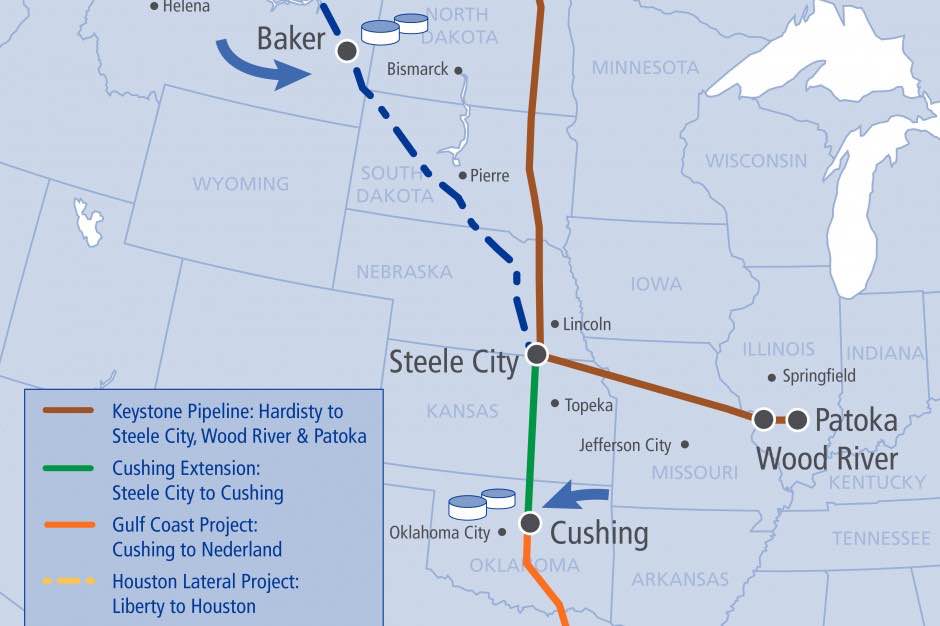April 2016, Vol. 243, No. 4
Web Exclusive
Keystone Outage Affects North American Crude Stock Levels

The recent eight-day outage on TransCanada’s cross-border Keystone pipeline potentially removed 4.6 MMbbls of oil from entering the United States from Canada and was a widespread influence on crude stock levels in both countries, according to Genscape.
The 590,000 bpd pipeline resumed flow April 10 after being shut down due to a leak near the Freeman pumping station in South Dakota. The Keystone pipeline system flows from Hardisty, AB, to Steele City, NE. From there, crude flows to either Patoka, IL or Cushing, OK, where stocks declined greatly last week.
Genscape monitors detected the pipeline restart at about 12:30 p.m. EST April 10 and issued an alert to customers at 3 p.m. EST. The pipeline restarted a day later than was expected. TransCanada issued a statement April 8, indicating the company was granted conditional approval by the U.S. Department of Transportation Pipeline and Hazardous Materials Safety Administration to resume delivering crude on the Keystone Pipeline system, following completion of repairs.
The pipeline was expected to restart at reduced pressure, according to TransCanada.
Crude inventories at Cushing fell 1.5 MMbbls for the week ending April 8, after flow on the Keystone to the hub decreased 291,000 bpd to 26,000 bpd. The stock decline marked the largest draw at the storage hub since Sept. 11, 2015, when inventories had a week-over-week decline of 1.8 MMbbls.
Despite the large draw, inventories on April 8were only 2.3 MMbbls from the record high of 69.65 MMbbls set March 15. Capacity use of operational storage at Cushing was 77% on April 8. This is 2% below the all-time high set March 11. Assuming an operational maximum of 80% use for Cushing, there is an estimated 2.6 MMbbls of available storage space.
West Texas Flow
Meanwhile, flow on the Wichita Falls, TX,-to-Cushing 450,000 bpd segment of Plains All American’s Basin pipeline increased, supplementing lower flows to Cushing from Canada. The weekly average basin pipeline flow increased 108,000 bpd to 352,000 bpd for the week.
In addition, West Texas storage inventories dropped 686,000 bbls as pipeline flow from West Texas to Cushing increased. Stock levels at Midland, TX, and Wichita Falls fell 1.28 MMbbls collectively, coinciding with higher outbound basin pipeline flows.
The Keystone outage was not expected to affect volumes on TransCanada’s 700,000 bpd Gulf Coast pipeline, which uses the facilities of the southern leg of the Keystone system from Cushing to the U.S. Gulf Coast, according to TransCanada on April 4. Weekly average flows on TransCanada’s 700,000 bpd Gulf Coast pipeline decreased 7,000 bpd to 341,000 bpd for the week.
Patoka Inventories Fall
The Keystone outage also led to stock declines at the storage hub in Patoka, IL, which has a capacity of nearly 19 MMbbls. Storage inventories in Patoka decreased 564,000 bbls to 9.3 MMbbls. Keystone flows into Patoka were lower by about 233,000 bpd, offsetting increased deliveries into Patoka on the Marathon-operated 1.2 MMbpd Capline Pipeline.
Flows on Capline, which delivers crude from St. James, LA, increased 77,000 bpd to 232,000 bpd for week ending April 8, 2016. In March 2016, Capline flows to Patoka averaged 147,000 bpd while Keystone flows to Patoka averaged 262,000 bpd.
West of Patoka, use at the Phillips 66 305,000 bpd Wood River, IL, refinery was reduced due to the Keystone pipeline outage as well, according to Reuters. Genscape detected the shutdown of the 64,000 bpd crude section and 16,000 bpd coker on April 4. The units began restarting April 12, according to Genscape.
Canada Back Up
As the Keystone outage decreased outgoing pipeline takeaway, barrels backed up in Western Canada. Stocks there climbed 1.5 MMbbls to more than 28 MMbbls last week, reaching the highest level recorded since Genscape coverage began in 2010. Stocks are expected to fall in coming weeks after the return of Keystone flow slackens bottlenecks formed in the region.
The stock increase was driven by a 1.8 MMbbl build in Hardisty, AB. Inventories at the hub reached a record high last week of more than 13 MMbbls. The largest inventory build ups took place at the TransCanada and Gibson terminals, which feed Keystone.
Terminals at the Hardisty hub used less than 62% of capacity last week. A record-high rate of 68% was set week ending Dec. 31, 2010. More than 5 MMbbls of additional storage capacity has come online at the Hardisty hub since then, with another 5.7 MMbbls of capacity under construction. Nearly 2.7 MMbbls of the new capacity is being constructed by TransCanada.
By Hillary Stevenson, Marcus Waldner and Dylan White, Oil Analysts, Genscape





Comments